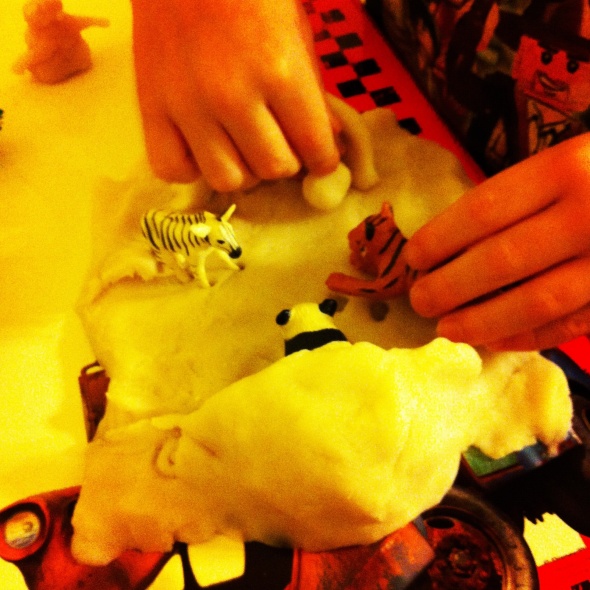Themed Play vs. Free Play
Posted: February 13, 2013 Filed under: Activities for Kids, Education, Parenting | Tags: #play, activities, children, children's activities, choices, education, free play, parenting, playtime, preschool activities, themed activities, themes 4 CommentsWhen it comes to planning activities for children, one thing that parents, teachers, and children seem to enjoy is a fun theme. Whether we are deciding nursery decor, planning a birthday party, or just a simple craft on a Saturday afternoon, many of us like to utilize a good theme. Right now, Pinterest is full of Valentine’s day themed projects and learning activities for children. Next week, we will start seeing a lot of green art projects and flowered crafts for St. Patty’s Day and spring. I’m no exception. In fact, I’m working on an idea for an activity planner for young children, and how is it organized? By themes!
Themes can make playtime more exciting. Having a theme is a good way to explore one subject in many different ways. That’s especially beneficial for families with more than one young child, or for a group setting like a preschool or child care center. One child may not be too fond of journaling about the weather, but making her own tornado sensory bottles might be most fun she’s had all week! And when your son loves to put together his own mini-pizza for a snack on Little Chef day, your daughter might prefer to create her own restaurant menu with a piece of paper and crayons.
And yet sometimes, our children want nothing to do with a theme. We may have spent a lot of time and effort putting together a Pirate theme day, filled with homemade pirate hats and eyepatches, decorating our own paper towel tube spyglass, following a treasure map using our directional skills, and count and sort our treasure after we’ve found it. We just knew it was going to be the best day ever! After all, little Betty Boop from the Super Happy Blogging Mom.com sure loved it! Instead, our little ones complain that the felt eyepatch is itchy. They slop a little paint on a paper towel tube and announce, “I’m done!” after a record time of 10.8 seconds. They whine that they’re too tired to follow the treasure map, and they’re disappointed when they finally find the treasure and realize that it’s only card stock with gold glitter and not real treasure!
So what can we do?
Here’s my best plan:
-Have a plan. I’ve found that if I don’t have a plan and the materials for the activities ready to go, interest on the children’s behalf fades fast. From a child’s perspective, nothing is more boring than waiting!
-Start the activity as planned, but then hand over the reins to the children whenever possible. If you offer your child the opportunity to draw their own treasure map, but they prefer to draw a football field instead, let him! I recently borrowed an idea from Arlee at Small Potatoes to make homemade play dough and add some animals and trees for a fun winter animal play scene that I was sure my six-year-old would play with for hours! (Yes, I can be a bit delusional at times.) He was completely uninterested. He wanted to go back to playing floor hockey in the living room, which I reminded him was a bad idea since his dad and little brother were taking a nap. In an attempt to keep him at the table longer spark his interest, I started shaping a cave out of the play dough. “Great idea!” my son said. “Can you make another net on this end so I can play soccer with the animals?” For a moment, I was disappointed that he didn’t enjoy the activity in the way I had imagined. But I realized that he was enjoying the way he imagined instead, and that it was a much more memorable and valuable play experience for him. He played for quite a long time, whereas he would have whined and complained and shut down in about two minutes had I insisted on him playing my way.
-Be adaptable. That’s one of the best qualities that a parent or teacher can have. Children are so unpredictable. From the time they are first born until who-knows-when, just when we think we have them figured out, they change. It’s the ebb and flow of growing up, of a child’s discovery of who they are going to become. Our job as parents and teachers is not to determine WHO they will be, but to help them learn HOW they will get there. If our child wants to be a ballerina, but we are pushing them to be a soccer player instead, we’re not doing anyone a favor. If we’re trying to teach them to kick, pass, and shoot when they just want to twirl, bend, and leap, there is going to be a constant struggle. And they will probably still end up being a ballerina.
Now this isn’t to say that children should just have free rein of their world. Certainly, some limits need to be in place–for their benefit and ours. I certainly don’t mean that if a child isn’t interested in practicing math at home that we should ban math from our routine. It just means that if they want to make up a subtraction story about a basketball team rather than about spring chickens, let them! Another option is to let them know that as soon as they have completed the planned learning activity, they may have free play to explore the items any way they choose. They might just end up surprising you by how much they learn through their own free play.
Which do you prefer, themed play or free play? Which do your children prefer?



